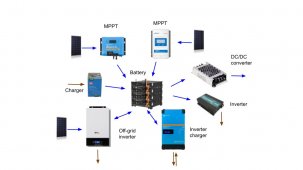Hello All,
I have a Growatt 3000 All in one inverter and I have max out its MPPT Capacity. Because of the Battery Bank size it never reaches full charge in one day.
It is possible to add a second solar array using an external MPPT to the system without damaging the Inverter internals? The attached diagram shows two possible
point on where to connect the second MPPT. My guess will be point A so the shunt registers the current coming into the batteries. But the main question is if it
might damage the Growatt in any way.
I have a Growatt 3000 All in one inverter and I have max out its MPPT Capacity. Because of the Battery Bank size it never reaches full charge in one day.
It is possible to add a second solar array using an external MPPT to the system without damaging the Inverter internals? The attached diagram shows two possible
point on where to connect the second MPPT. My guess will be point A so the shunt registers the current coming into the batteries. But the main question is if it
might damage the Growatt in any way.




